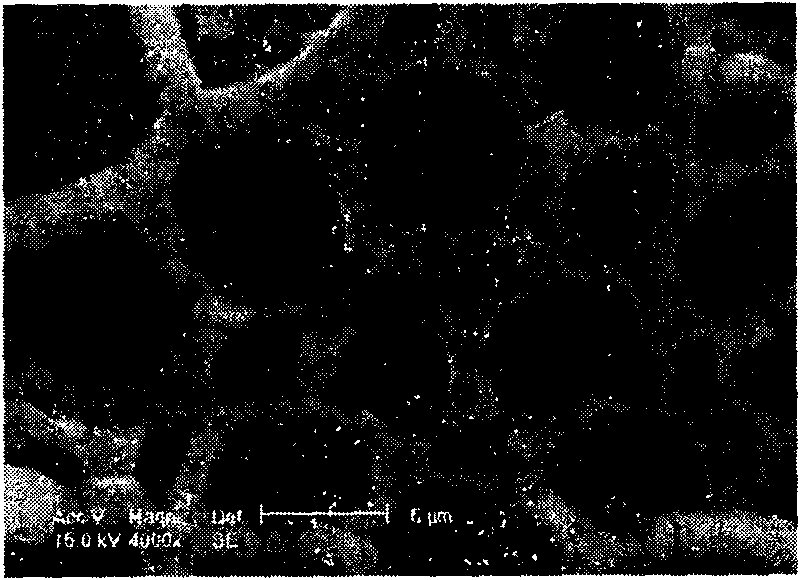Preparation method of microbe immobilized particles for restoring pesticide contaminated soil
A technology for microbial immobilization and pesticide-contaminated soil is applied in the field of in-situ remediation of pesticide-contaminated soil to achieve the effects of high bacterial count, good ventilation and low price.
- Summary
- Abstract
- Description
- Claims
- Application Information
AI Technical Summary
Problems solved by technology
Method used
Image
Examples
Embodiment 1
[0042] See attached Figure 5 , (1) Crushing and screening of carbon blocks:
[0043] Break the large pieces of charcoal, and sieve out small particles with a diameter of 0.80mm and a specific surface area of 1155m 2 / g, pore volume 0.86cm 3 / g. Then the charcoal particles were aerated in distilled water for 5 hours to remove the charcoal powder and dust attached to the surface, and dried for later use. figure 1 , 2 is an electron micrograph of the charcoal particles.
[0044] (2) Bacterial slant culture:
[0045] Pseudomonas (Pseudomonas sp .) Placed in a 28-30°C incubator for 48 hours on a slant.
[0046] (3) Preparation of bacterial seed solution:
[0047] Receive 2 rings of bacterial lawn on the slant medium with an inoculation loop, insert into the liquid seed medium (its component weight ratio is: glucose 1.25%, beef extract 0.25%, NH 4 NO 3 0.1%, MgSO 4 ·7H 2 O 0.02%, KCl 0.02%, pH 7.0-7.2), under the conditions of shaking table speed 130-150r / min, 28-30 ...
Embodiment 2
[0062] The difference from Example 1 is:
[0063] The carrier material is bamboo charcoal particles with a particle size of 1.60mm and a specific surface area of 860m 2 / g, pore volume 0.77cm 3 / g.
[0064] The bacterial species is Bacillus sp.
[0065] The crosslinking agent is an aqueous solution of carboxymethyl cellulose with a mass concentration of 3%.
[0066] The primary reinforcing agent is an aqueous solution of chitosan with a mass concentration of 1.5%, and the secondary reinforcing agent is an aqueous solution of sodium alginate with a mass concentration of 2.5%.
[0067] The immobilized particle dosage ratio is 5%, when the initial concentration of 2,4-D in the soil is 40mg / kg, the removal rate of 2,4-D is 42% after repairing for 35 days.
Embodiment 3
[0069] The difference from Example 1 is:
[0070] The carrier material is coconut shell-based granular carbon with a particle size of 0.80mm and a specific surface area of 1104m 2 / g, pore volume 0.82cm 3 / g.
[0071] The bacterial species is Micrococcus sp.
[0072] The crosslinking agent is an aqueous solution of 4% carboxymethyl cellulose in mass concentration.
[0073] The primary reinforcing agent is an aqueous solution of chitosan with a mass concentration of 2%, and the secondary reinforcing agent is an aqueous solution of sodium alginate with a mass concentration of 2%.
[0074] The immobilized particle dosage ratio is 2%, when the initial concentration of bensulfuron-methyl in the soil is 20mg / kg, the removal rate of bensulfuron-methyl is 62% after 28 days of restoration.
PUM
| Property | Measurement | Unit |
|---|---|---|
| Particle size | aaaaa | aaaaa |
| Specific surface area | aaaaa | aaaaa |
| Pore volume | aaaaa | aaaaa |
Abstract
Description
Claims
Application Information
 Login to View More
Login to View More - R&D
- Intellectual Property
- Life Sciences
- Materials
- Tech Scout
- Unparalleled Data Quality
- Higher Quality Content
- 60% Fewer Hallucinations
Browse by: Latest US Patents, China's latest patents, Technical Efficacy Thesaurus, Application Domain, Technology Topic, Popular Technical Reports.
© 2025 PatSnap. All rights reserved.Legal|Privacy policy|Modern Slavery Act Transparency Statement|Sitemap|About US| Contact US: help@patsnap.com



